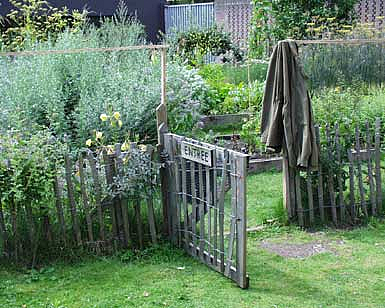the Garden of Rudy J. Luijters
Calendarium
March 2001 - March 2003
Since the first day of spring 2001, the garden has been the domain of Rudy Luijters (The Hague, 1955). Luijters has given his project the title Calendarium: for a period of two growing seasons, until the autumn of 2002, he will observe and record all of the natural changes and events that occur there. For this, he will partly restructure the garden and resituate plants in order to create a diversity of flora and fauna. The garden will thereby become a place to which the viewer is invited for various experiences of a natural passage of time.
In restructuring the garden and resituating plants, Luijters is not concerned with the aesthetics of garden design or combinations of plants. He does not aim to create an ornamental garden with borders, beds and bowers; nor does he seek to achieve a classical design or romantic effects by which the garden could be experienced as an idyllic realm of cultivated nature. The garden is primarily a vacant piece of urban land on which all sorts of plants and animals appear to feel at home. It is a living environment for trees, plants and flowers, mosses and grasses, insects, birds and even rabbits. A group of birches has been standing there for many years; two beeches have been replanted recently; the fruit-trees and daffodils date from ‘the garden of John Körmeling’. The path that served as a ‘road’ for Rosemarie Trockel’s kiddy cars has been sown with all sorts of grasses and indigenous plants. Though he wishes to intervene as little as possible, he has nonetheless had to make several adjustments. Because the Calendarium focuses on natural processes and changes, Luijters has placed a variety of plants, flowers and herbs in the garden–some of these in two large nursery beds and two hotbeds. A garden house on wheels serves as an observation post and temporary work space. Luijters wishes to provide an account of events in the garden in various ways. In De Pont’s quarterly bulletin and on its website (www.depont.nl) the seasons are followed in a special column containing images and updates. Luijters also wishes to establish a link between the indoor and the outdoor spaces of the museum by showing video registrations taken in the garden on monitors inside the museum and by allowing edible crops and herbs to be used in the restaurant.
Luijters has looked at countless other examples on the basis of his interest in museum gardens, but only rarely did he find a garden that had actually been layed out by an artist. A museum garden is ordinarily used as an outdoor space for sculpture and as a place for visitors to relax. Its arrangement is usually an aesthetic one (as a complement to the building and the surroundings) and a functional one (serving as a sculpture park or an outdoor café). In terms of concept or execution, the garden is almost never regarded as the intervention and the vision of an artist. Among the most prominent exceptions to this is the garden which the German artist Lothar Baumgarten has created for Fondation Cartier in Paris.
To Rudy Luijters, the garden is mainly a work space and a demarcated area for investigation, registration and inventory. He studies the continual change that occurs in a natural environment not in the manner of a biologist, a nurseryman or a gardener, but as an artist for whom curiosity and focus have prime importance. His remote living environment in the Walloon countryside offers him, in that respect, an abundance of material. But even a piece of ground in the urban surroundings of Tilburg is a surprising biotope.
The observations and registrations lead to the compiling and ordering of information. The principles of order applied by Luijters are not functional or scientific, but are self-determined and associative. His kleurenkaarten (color cards) provide order on the basis of color, material and structure (that of flowers, leaves, mosses and barks, for instance). It is a system with its own logic which Luijters offers in contrast to the (economic) standardization by which the world is usually measured, classified and ‘demystified’.
Sometimes he makes an account of his registrations in series of watercolors of vegetables, fruit or mushrooms. Or he reproduces a series of ‘non-architectonic structures’ (sheds, huts and lookout posts) on a smaller scale. In the Alblasserwaard he has built observation huts that offer a view of the landscape, and around the Energie Centrum Nederland he has planted a five-kilometer hedge of roses. But maintaining his vegetable garden and producing his own honey are just as much a part of his artistry. His continual concern is our relationship with and experience of the landscape and nature through all of the senses–by looking, listening, smelling, tasting and touching. These sensory experiences are also the main focus of his garden project for De Pont. The Calendarium is like a medieval book of hours in which the seasons are depicted as a panorama of human life in nature.
